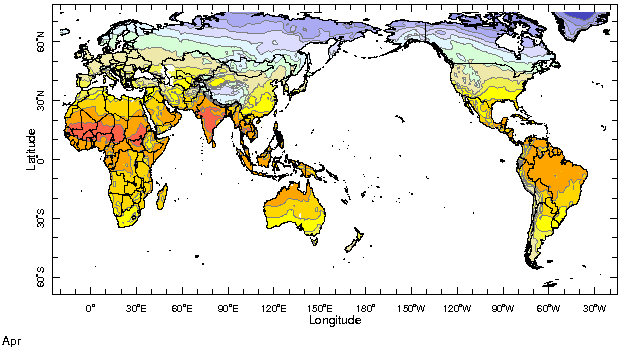|
IRI Climate Digest
May 2002
April Global Climate Summary
Climatological Background
In April, the sun's migration into the Northern Hemisphere has begun, bringing springtime to the northern mid-latitudes. The monsoon systems which still linger south of the equator will move northward following the solar heating of the continents in the next two months. In the Southern Hemisphere, fall has arrived, with cooler temperatures and a strengthening of the mid-latitude storm tracks.
Monthly Mean Temperature (1961-1990), data from the Climate Research
Unit, University of East Anglia


Monthly Mean Precipitation (1961-1990), data from the Climate Research
Unit, University of East Anglia


Temperatures
Over Eurasia, the very unusually warm temperatures that had been in place in recent months decreased dramatically, while above-average temperatures persisted over southern Brazil and returned to Australia and southern North America.
Europe and Asia: Except for Scandinavia and parts of southwest Asia, the much warmer than normal conditions that had dominated since January gave way to near-normal temperatures. Most dramatically, cooler than normal conditions developed from the Caspian Sea to central Russia.
North America: Unusually cool temperatures continued over much of the western half of Canada and eastern Alaska, while warm anomalies developed over northern Mexico and the southwest and eastern U. S.
South America: Warmer than normal conditions remained in place over most of northern South America and intensified in southern Brazil.
Africa: Warmer than normal temperatures continued over much of the continent. Compared to March, above-normal temperatures weakened slightly along the Mediterranean coast and increased over South Africa and Botswana.
Australia: Above-average temperatures dominated most of Australia in April.
Temperature Difference from the 1961-1990 mean, with data
from NCEP Climate Prediction Center, CAMS.


Precipitation
Unusually dry conditions continued to persist across southern China and Taiwan. It was a dry start to the dry season in eastern Australia while heavy rains continue in Ecuador and Uruguay.
Africa: In the Greater Horn, rainfall was well above average across central Kenya and southern sections of Ethiopia ans Somalia. In southern Africa, above average late season rains brought limited relief to drought conditions in Zimbabwe and southern Zambia. Above average rainfall was welcomed in Morocco in North Africa following a prolonged period of generally deficient precipitation.
South America: Heavy rains continued across sections of coastal and western Ecuador as well as western Peru. Much of Brazil observed below average rainfall as the dry season approaches while further south in Uruguay and southern Paraguay, unusually wet conditions persisted in April.
North and Central America: Late season snows fell across the Canadian Prairies which had an unusually dry winter while above average precipitation helped ease drought conditions in the northeastern United States. Below average rainfall persisted across the north-central and southwestern US.
East and Southeast Asia:Unusually dry conditions were once again seen from southern China eastward to Taiwan and southern Japan. Below average rainfall persisted across much of Vietnam.
Southwest Asia: Locally heavy rainfall triggered flash floods in northern Afghanistan and Tajikistan. Precipitation was above average across western and northern Iran and unusually wet conditions persisted across much of Kazakhstan in the Former Soviet Union.
Australia and New Zealand: Much of eastern Australia and Tasmania saw deficient rainfall in April as did the North Island of New Zealand.
Europe: Precipitation was generally slightly below average across much of the region.
Precipitation Difference from 1961-1990 mean, with data
from NCEP Climate Prediction Center, CAMS-OPI.


Oceanic Conditions
Tropical Pacific: The equatorial Pacific retreated somewhat from its movement towards the development of an El Niņo as above average sea surface temperatures in the eastern equatorial Pacific weakened during the month of April. Temperatures continue to remain above average near the dateline. Although there continues to be an enhanced likelihood of an El Niņo relative to an average year the latest IRI assessment indicates a decrease in the probability compared to the previous month. Please see the latest IRI ENSO Update for a detailed summary and outlook.
Indian Ocean:Sea surface temperatures remained above average in much of the central and eastern Indian ocean, but were continuing to cool south of the equator in the western part of the basin. The warm anomalies off the west coast Africa showed decay.
Mid latitudes: Below average sea surface temperatures in the central North PAcific warmed significantly to near average during April. Temperatures continued to be above average across much of the central South Pacific as well as along the western coast of southern Africa in the Atlantic.
Monthly Sea Surface Temperature Difference from the 1950-1979 mean,
with data from the Environmental Modeling Center, NCEP/NOAA.


Contents |
Special |
Impacts |
Climate |
Forecast
| 
